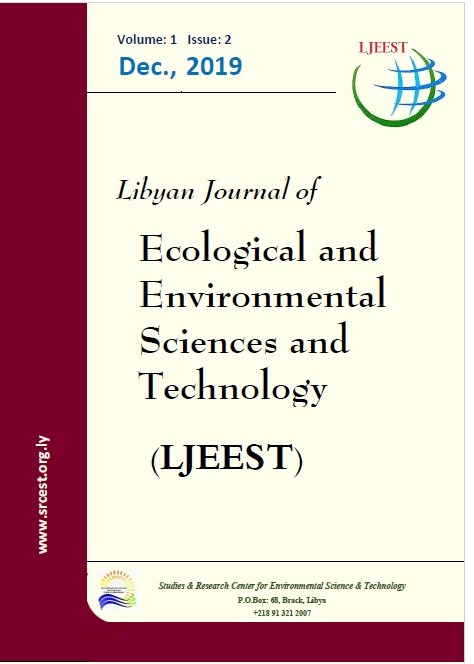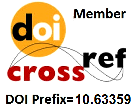Using Algorithm (Levenberg marquardt) as Activation Function to Prediction Water Quality Index (WQI) in Kastamonu City-Turkey
DOI:
https://doi.org/10.63359/8jfhe511Keywords:
ANN, Karaçomak dam, Water Quality IndexAbstract
The computer program of artificial neural network (ANN) to prediction the water quality index (WQI) at Municipality Water of Kastamonu City-Turkey. WQI demonstrates the overall water quality at a specific site and specific time depending on some water quality factors for 5 years (from Jan 2011 to Dec 2015). The simple feedforward network is applied with one of the training algorithms the standard back-propagation algorithm (Levenberg-Marquardt) (train-lm). In this study, one hidden layer has been selected for modelling and the number of the hidden neuron is set (n+1) and (2n+1) of input nodes. This discovering can be depicted by using the way that the quantity of hidden neurons straightforwardly affects the execution of the system and we can see that model the standard back-propagation algorithm (Levenberg-Marquardt) train-lm as activation function (train-Lm) is optimal to predict of water quality index and as more direct and very effective options to predict surface water quality and other water bodies.
References
Abdolmaleki, Ahangar, & Soltani. (2013). Artificial Neural Network (ANN) approach for predicting Cu concentration in drinking water of Chahnimeh1 Reservoir in Sistan-Balochistan, Iran. Health scope, 2(1), 31-38.
Almasri, & Kaluarachchi. (2005). Modular neural networks to predict the nitrate distribution in ground water using the on-ground nitrogen loading and recharge data. Environmental Modelling & Software, 20(7), 851-871.
Asuquo, & Etim. (2012). Water quality index for assessment of borehole water quality in Uyo metropolis, Akwa Ibom state, Nigeria. International Journal of Modern Chemistry, 1(3), 102-108.
Banejad, & Olyaie. (2011). Application of an Artificial Neural Network Model to Rivers Water Quality Indexes Prediction–A Case Study. Journal of American Science, 7(1), 60-65.
Bayazit, & Avci. (1997). Water resources of Turkey: potential, planning, development and management. International Journal of Water Resources Development, 13(4), 443-452.
Chaipimonplin. (2016). Investigation internal parameters of neural network model for Flood Forecasting at Upper river Ping, Chiang Mai. KSCE Journal of Civil Engineering, 20(1), 478-484.
Chatterjee, & Raziuddin. (2002). Determination of Water Quality Index(WQI) of a degraded river in Asansol industrial area(West Bengal). Nature, Environment and Pollution Technology, 1(2), 181-189.
Daliakopoulos, Coulibaly, & Tsanis. (2005). Groundwater level forecasting using artificial neural networks. Journal of hydrology, 309(1), 229-240.
Erturk, Gurel, Ekdal, Tavsan, Ugurluoglu, Seker, . . . Ozturk. (2010). Water quality assessment and meta model development in Melen watershed–Turkey. Journal of environmental management, 91(7), 1526-1545.
Faruk. (2010). A hybrid neural network and ARIMA model for water quality time series prediction. Engineering Applications of Artificial Intelligence, 23(4), 586-594.
Fletcher, & Goss. (1993). Forecasting with neural networks: an application using bankruptcy data. Information & Management, 24(3), 159-167.
Garcia, & Shigidi. (2006). Using neural networks for parameter estimation in ground water. Journal of hydrology, 318(1), 215-231.
Gazzaz, Yusoff, Aris, Ahmad , Ramli, & Mohammad. (2012). Artificial neural network modeling of the water quality index for Kinta River (Malaysia) using water quality variables as predictors. Marine Pollution Bulletin, 64(11), 2409-2420.
Hajnayeb, Ghasemloonia, Khadem, & Moradi. (2011). Application and comparison of an ANN-based feature selection method and the genetic algorithm in gearbox fault diagnosis. Expert systems with Applications, 38(8), 10205-10209.
Heydari, Olyaie, Mohebzadeh, & Kisi. (2013). Development of a neural network technique for prediction of water quality parameters in the Delaware River, Pennsylvania. Middle-East Journal of Scientific Research, 13(10), 1367-1376.
Imneisi, & Aydin. (2016). Water Quality Index (WQI) for Main Source of Drinking Water (Karaçomak Dam) in Kastamonu City, Turkey. J Environ Anal Toxicol, 6(407), 2161.
Jakeman, Letcher, & Norton. (2006). Ten iterative steps in development and evaluation of environmental models. Environmental Modelling & Software, 21(5), 602-614.
Juahir, Zain, Toriman, Mokhtar, & Man. (2004). Application of artificial neural network models for predicting water quality index. Jurnal Kejuruteraan Awam, 16(2), 42-55.
Kaastra, & Boyd. (1995). Forecasting futures trading volume using neural networks. Journal of Futures Markets, 15(8), 953-970.
Karul, Soyupak, Çilesiz, Akbay, & Germen. (2000). Case studies on the use of neural networks in eutrophication modeling. Ecological Modelling, 134(2), 145-152.
Khalil, Awadallah, Karaman, & El-Sayed. (2012). Application of artificial neural networks for the prediction of water quality variables in the Nile Delta. Journal of Water Resource and Protection, 4(6), 388.
Kim, Loucks, & Stedinger. (2012). Artificial neural network models of watershed nutrient loading. Water resources management, 26(10), 2781-2797.
Maier, & Dandy. (2000). Neural networks for the prediction and forecasting of water resources variables: a review of modelling issues and applications. Environmental Modelling & Software, 15(1), 101-124.
Maier, Jain, Dandy, & Sudheer. (2010). Methods used for the development of neural networks for the prediction of water resource variables in river systems: current status and future directions. Environmental Modelling & Software, 25(8), 891-909.
Manoj, & Padhy. (2014). Multivariate statistical techniques and water quality assessment: Discourse and review on some analytical models. International Journal of Environmental Sciences, 5(3), 607.
May, Dandy, Maier, & Nixon. (2008). Application of partial mutual information variable selection to ANN forecasting of water quality in water distribution systems. Environmental Modelling & Software, 23(10), 1289-1299.
Moasheri, Khammar, Poornoori, Beyranvand, & Soleimani. (2013). Estimate the spatial distribution TDS the fusion method Geostatistics and artificial neural networks. International Journal of Agriculture and Crop Sciences, 6(7), 410.
Najah, Elshafie, Karim, & Jaffar. (2009). Prediction of Johor River water quality parameters using artificial neural networks. European Journal of Scientific Research, 28(3), 422-435.
Nasir, Juahir, Roslan, Mohd, Shafie, & Ramli. (2011). Artificial Neural Networks Combined with Sensitivity Analysis as a Prediction Model for Water Quality Index in Juru River, Malaysia. International Journal of Environmental Protection.
Nasr, & Zahran. (2014). Using of pH as a tool to predict salinity of groundwater for irrigation purpose using artificial neural network. The Egyptian Journal of Aquatic Research, 40(2), 111-115.
Panda, Garg, & Chaubey. (2004). Artificial neural networks application in lake water quality estimation using satellite imagery. Journal of Environmental Informatics, 4(2), 65-74.
Qiuhua, Lihai, Tingjing, Lei, Teng, Guojia, . . . Cunxiong. (2014). Use of principal component scores in multiple linear regression models for simulation of chlorophyll-a and phytoplankton abundance at a karst deep reservoir, southwest of China. Acta Ecologica Sinica, 34(1), 72-78.
Rooki, Ardejani, Aryafar, & Asadi. (2011). Prediction of heavy metals in acid mine drainage using artificial neural network from the Shur River of the Sarcheshmeh porphyry copper mine, Southeast Iran. Environmental earth sciences, 64(5), 1303-1316.
Sakthivel, Ravichandran, & Alagumurthi. (2016). Modeling and Prediction of flexural strength of hybrid mesh and fiber reinforced cement- based comosites using Artificial Neural Network (ANN). international journal of Geotech.,Const.Mat. and Environmental, 10(1), 1623-1635. doi: 2186-2990
Singh, Basant, Malik, & Jain. (2009). Artificial neural network modeling of the river water quality—a case study. Ecological Modelling, 220(6), 888-895.
Srinivasan, Dipti Liew, & AC Chang. (1994). A neural network short-term load forecaster. Electric Power Systems Research, 28(3), 227-234.
SUJANA, VERMA, & SHWETA. (2015). Application of ANN model for the prediction of Water Quality Index. International Journal of Engineering Research and General Science, 3(1).
Swingler. (1996). Applying neural networks: a practical guide: Morgan Kaufmann.
Tyagi, Sharma, Singh, & Dobhal. (2013). Water quality assessment in terms of water quality index. American Journal of Water Resources, 1(3), 34-38.
Wechmongkhonkon, & Areerachakul. (2012). Application of Artificial Neural Network to Classification Surface Water Quality. World Academy of Science, Engineering and Technology, International Journal of Environmental, Chemical, Ecological, Geological and Geophysical Engineering, 6(9), 574-578.
Wu, Dandy, & Maier. (2014). Protocol for developing ANN models and its application to the assessment of the quality of the ANN model development process in drinking water quality modelling. Environmental Modelling & Software, 54, 108-127.
Yesilnacar, Sahinkaya, Naz, & Ozkaya. (2008). Neural network prediction of nitrate in groundwater of Harran Plain, Turkey. Environmental Geology, 56(1), 19-25.
Yisa, & Jimoh. (2010). Analytical studies on water quality index of river Landzu. American Journal of Applied Sciences, 7(4), 453.
YUAN, GONG, ZHANG, & WANG. (2013). Forecasting the water quality index in Zaohe River based on BP neural network model [J]. Journal of Safety and Environment, 2, 023.
Zhang, & Stanley. (1997). Forecasting raw-water quality parameters for the North Saskatchewan River by neural network modeling. Water research, 31(9), 2340-2350.
Published
Issue
Section
License

This work is licensed under a Creative Commons Attribution-NonCommercial 4.0 International License.















